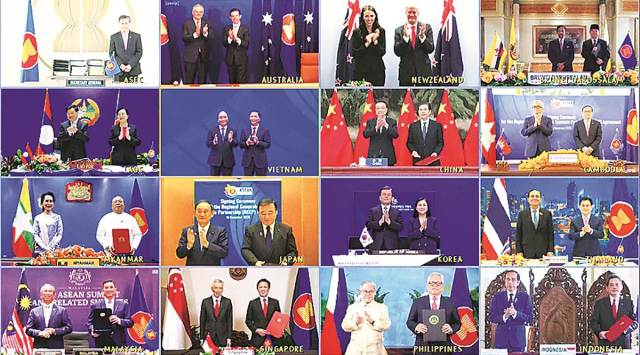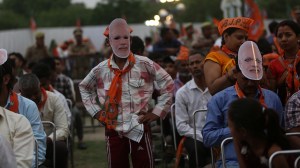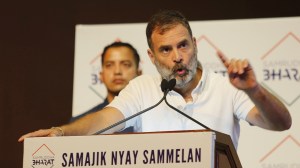- India
- International
Study on benefits, costs helped govt firm up RCEP stand
Where RCEP members are concerned, India’s deficits have marginally reduced in most cases. However, its total deficit with ASEAN as a bloc has increased between 2018-19 and 2019-20, according to data from the Ministry of Commerce and Industry.
 An official said that India was not averse to trade pacts, given that negotiations for some 20 trade pacts with countries and groups of countries have been initiated by it. However, the government has objections to joining RCEP “in its current form”.
An official said that India was not averse to trade pacts, given that negotiations for some 20 trade pacts with countries and groups of countries have been initiated by it. However, the government has objections to joining RCEP “in its current form”.An internal assessment of India’s bilateral free trade agreements with nine countries, including five signatories of the Regional Comprehensive Economic Partnership (RCEP), played a pivotal role in the government firming its position against joining the mega trade pact. The assessment showed a “moderate utilisation rate” of Free Trade Agreements (FTAs) over a five-year period, and a trade deficit for India in most cases, save in regard to SAARC nations, The Indian Express has learnt.
While the remaining RCEP members went ahead and inked a deal on Sunday — a little over a year after Prime Minister Narendra Modi announced India was walking out of negotiations citing “significant outstanding issues” — the bloc has made it clear that the door for India to return to the negotiating table will remain open.
Read | RCEP: Door still open for India, may take part in meets as ‘observer’
However, India’s escalating political tensions with China over the last year are seen as having pushed up the entry barrier for the government. Also, given that India already has bilateral pacts with a number of RCEP members including the ASEAN bloc, South Korea, and Malaysia — and is negotiating agreements with some of the remaining RCEP members such as Thailand, Australia and New Zealand — the cost of opting out of the deal is being seen as not outweighing the benefits of keeping China’s looming presence at bay.
Officials also pointed to work that is underway to activate the trilateral Supply Chain Resilience Initiative (SCRI) with Japan and Australia that aims to increase collaboration and cut the dependency on Chinese inputs. Also, there is a growing view that it would serve India’s interest to invest strongly in negotiating bilateral agreements with the United States and the European Union, both of which are currently work-in-progress.

Looming shadow of China
However, it has been conveyed to other signatories of RCEP that ‘Act East’ was the bedrock of India’s economic policy, and that its engagement with ASEAN countries and other trading partners would continue, a government official involved in the exercise told The Indian Express.
Also Read | Jaishankar defends decision to not sign RCEP
The government’s assessment of various bilateral trade agreements has revealed that the growth in trade (CAGR) with partners over the last five financial years was a modest 7.1 per cent. While “there has been growth rate in both imports from and exports to these FTA partners”, the “utilisation rate” of FTAs both for India and its partners has been “moderate” across sectors, according to this study, which covers pacts signed with Sri Lanka, Afghanistan, Thailand, Singapore, Japan, Bhutan, Nepal, Republic of Korea and Malaysia.
The only exceptions to these findings include sectors such as iron and steel for the India-Korea Comprehensive Economic Partnership Agreement (CEPA) and India-Japan CEPA; plastics in the case of the India-Singapore Comprehensive Economic Cooperation Agreement; and automobiles and automotive components in the case of the India-Malaysia CECA. What has also been mentioned, officials said, is the lopsided trade deficit against India in most of these deals.
Editorial | Trade lifts all boats, New Delhi must get inside the RCEP tent at the earliest opportune moment.
Where RCEP members are concerned, India’s deficits have marginally reduced in most cases. However, its total deficit with ASEAN as a bloc has increased between 2018-19 and 2019-20, according to data from the Ministry of Commerce and Industry.
The pullout from RCEP has come at a time when India is reviewing existing trade agreements based on “demand from domestic stakeholders” and “other inputs”.
Two reviews of the India Singapore CECA have been completed; the India-Bhutan Agreement on Trade Commerce and Transit was renewed in 2016; and the India-Nepal Treaty of Trade was extended in 2016. Eight rounds of negotiations have been completed for the review of the India-Korea CEPA, which commenced in 2016. India has taken up the review of the India-Japan CEPA and India-ASEAN FTA with its trading partners.
While the possibility of India joining RCEP as an observer is not being ruled out, officials indicated that “the current structure of RCEP” did not reflect the RCEP Guiding Principles or address the outstanding issues and concerns of India.
An official said that India was not averse to trade pacts, given that negotiations for some 20 trade pacts with countries and groups of countries have been initiated by it. However, the government has objections to joining RCEP “in its current form”.
“China has been a central figure in the East Asian region and, therefore, would have a major role in driving RCEP. However, there are several measures that India has taken after the Chinese aggression earlier this year, many of which would sit uncomfortably with its commitments under RCEP, should it join the agreement,” said trade expert Biswajit Dhar, a professor at Jawaharlal Nehru University’s Centre for Economic Studies and Planning.
“The reasons for which India walked out of RCEP last year have not changed. They haven’t improved and, in fact, have gotten worse, because there was earlier only an economic threat from China. Now, it exists on the political front as well,” Prof Dhar told The Indian Express.
Apr 25: Latest News
- 01
- 02
- 03
- 04
- 05







































